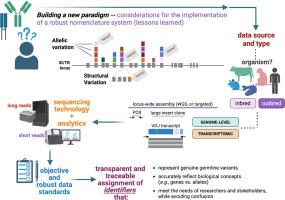Challenges for the immunoglobulin and T cell receptor gene nomenclatures in the modern genomics era
引用次数: 0
Abstract
For over thirty years, an approach to the nomenclatures of human immunoglobulin (IG) and T cell receptor (TR) genes has operated successfully and has been widely supported by the research community. The principles behind the human nomenclatures were then applied to the development of nomenclatures for IG and TR genes in non-human species. More recently, however, genomic sequencing has highlighted the limitations of this historic approach to nomenclature. The sequencing of IG and TR gene loci from multiple individuals and from a number of species has unveiled an extraordinary level of structural variation within the loci of all species that have so far been studied in this way. The designated gene naming authority - the International Union of Immunological Societies (IUIS) IG and TR Nomenclature Sub-Committee - has determined that a more careful approach is required before the genes of any species are officially named. In this opinion piece, we outline the challenges of the IG and TR nomenclatures, hoping to stimulate dialogue within the research community. Such dialogue would help guide the formulation of official policies to determine the appropriate level of knowledge of a locus that should be required before official gene names can be assigned. Strategies are also presented that should allow the unambiguous reporting and discussion of IG and TR gene sequences if their official naming is delayed.

免疫球蛋白和T细胞受体基因命名在现代基因组学时代的挑战
三十多年来,一种命名人类免疫球蛋白(IG)和T细胞受体(TR)基因的方法已经成功运作,并得到了研究界的广泛支持。人类命名法背后的原则随后被应用于非人类物种IG和TR基因命名法的发展。然而,最近,基因组测序突出了这种历史命名方法的局限性。对多个个体和多个物种的IG和TR基因座的测序揭示了迄今为止以这种方式研究的所有物种的基因座内的异常水平的结构变异。指定的基因命名机构——国际免疫学会联合会(IUIS) IG和TR命名小组委员会——已经确定,在正式命名任何物种的基因之前,需要采取更谨慎的方法。在这篇观点文章中,我们概述了IG和TR命名所面临的挑战,希望能激发研究界的对话。这种对话将有助于指导官方政策的制定,以确定在指定官方基因名称之前对基因座的适当知识水平。如果IG和TR基因序列的正式命名延迟,还提出了应允许明确报告和讨论的策略。
本文章由计算机程序翻译,如有差异,请以英文原文为准。
求助全文
约1分钟内获得全文
求助全文
来源期刊

Immunoinformatics (Amsterdam, Netherlands)
Immunology, Computer Science Applications
自引率
0.00%
发文量
0
审稿时长
60 days
 求助内容:
求助内容: 应助结果提醒方式:
应助结果提醒方式:


